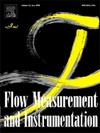Intelligent non-intrusive thermal flow rate meter designed for small diameter applications
IF 2.3
3区 工程技术
Q2 ENGINEERING, MECHANICAL
引用次数: 0
Abstract
Current non-intrusive flow measurement techniques still need improvements as they have disadvantages in small-diameter applications. This work proposes to develop a non-intrusive thermal flow meter to obtain the slightest full-scale deflection possible in low liquid flows. The meter uses a copper duct with an internal diameter of , six commercial K-type thermocouples, a microtubular heating resistance, and artificial intelligence to infer the flow rate from the thermal distribution on the duct surface. The sensors and the heater layout were calculated based on the theoretical temperature spread obtained from the physical model. To evaluate the meter, a test bench was built to control the heating resistor’s flow rate and temperature. The test bench is equipped with an electromagnetic flowmeter calibrated and certified in an external laboratory for reference and comparison, according to the ABNT (Brazilian Association of Norms Techniques) guidelines and the good practices used in the industries and calibration laboratories. In the meter evaluation, the resistance was activated so that the duct’s central region’s temperature remained at 70 degrees Celsius, and the thermal distribution data was collected with flow rates between 0.05 and with intermediate increases of . The experiment’s collected data were used to train the following models: linear regression, K-Nearest Neighbor (K-NN), Decision Tree, Random Forests, and Gradient Boosting. Deep learning models were also trained. The best result was obtained with k-NN, demonstrating that the built prototype could infer the flow rate with a full-scale deflection equal to 0.14%. As a result, the evaluation indicated that artificial intelligence algorithms could improve non-intrusive flow measurement systems compared to the proposed analytical thermal flow model.

智能非侵入式热流量计设计的小直径应用
目前的非侵入式流量测量技术在小口径应用中存在不足,需要进一步改进。这项工作建议开发一种非侵入式流量计,以在低液体流动中获得尽可能小的全尺寸偏转。该仪表采用内径22mm的铜管,6个商用k型热电偶,一个微管加热电阻,通过人工智能从管道表面的热分布推断流量。根据物理模型得到的理论温度分布计算了传感器和加热器的布局。为了对该仪表进行评价,搭建了一个试验台来控制加热电阻的流量和温度。根据ABNT(巴西规范技术协会)指南以及工业和校准实验室使用的良好实践,测试台架配备了在外部实验室校准和认证的电磁流量计,以供参考和比较。在仪表评价中,激活阻力使风管中心区域温度保持在70℃,在流量为0.05 ~ 0.6m3/h,中间增幅为0.01m3/h的情况下采集热分布数据。实验收集的数据用于训练以下模型:线性回归,k -最近邻(K-NN),决策树,随机森林和梯度增强。还训练了深度学习模型。k-NN得到了最好的结果,表明所建立的原型可以在全尺寸挠度为0.14%时推断出流量。因此,评估表明,与提出的分析式热流模型相比,人工智能算法可以改进非侵入式流量测量系统。
本文章由计算机程序翻译,如有差异,请以英文原文为准。
求助全文
约1分钟内获得全文
求助全文
来源期刊

Flow Measurement and Instrumentation
工程技术-工程:机械
CiteScore
4.30
自引率
13.60%
发文量
123
审稿时长
6 months
期刊介绍:
Flow Measurement and Instrumentation is dedicated to disseminating the latest research results on all aspects of flow measurement, in both closed conduits and open channels. The design of flow measurement systems involves a wide variety of multidisciplinary activities including modelling the flow sensor, the fluid flow and the sensor/fluid interactions through the use of computation techniques; the development of advanced transducer systems and their associated signal processing and the laboratory and field assessment of the overall system under ideal and disturbed conditions.
FMI is the essential forum for critical information exchange, and contributions are particularly encouraged in the following areas of interest:
Modelling: the application of mathematical and computational modelling to the interaction of fluid dynamics with flowmeters, including flowmeter behaviour, improved flowmeter design and installation problems. Application of CAD/CAE techniques to flowmeter modelling are eligible.
Design and development: the detailed design of the flowmeter head and/or signal processing aspects of novel flowmeters. Emphasis is given to papers identifying new sensor configurations, multisensor flow measurement systems, non-intrusive flow metering techniques and the application of microelectronic techniques in smart or intelligent systems.
Calibration techniques: including descriptions of new or existing calibration facilities and techniques, calibration data from different flowmeter types, and calibration intercomparison data from different laboratories.
Installation effect data: dealing with the effects of non-ideal flow conditions on flowmeters. Papers combining a theoretical understanding of flowmeter behaviour with experimental work are particularly welcome.
 求助内容:
求助内容: 应助结果提醒方式:
应助结果提醒方式:


